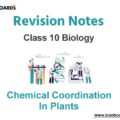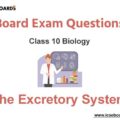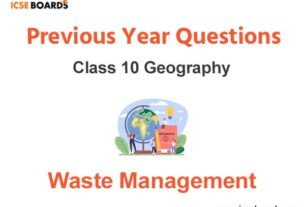Students should refer to Chemical Coordination in Plants ICSE Class 10 Biology Board Questions provided below with solutions. These will help the students to understand the type of questions which have been asked in previous year examinations and the type of solutions which the student should give to get good marks. You should also refer to ICSE Class 10 Biology Sample papers for more practice
ICSE Class 10 Biology Chemical Coordination in Plants Important Questions
Students should learn the important questions and answers given below for Chapter Chemical Coordination in Plants in Biology for ICSE Class 10. These board questions are expected to come in the upcoming exams. Students of ICSE Class 10th should go through the Important questions and answers ICSE Class 10 Biology which will help them to get more marks in exams.
Chemical Coordination in Plants ICSE Class 10 Biology Board Exam Questions
Chemical Coordination in Plants ICSE Class 10 Biology Board Questions
Question. Fill in the blanks and rewrite the complete statements:
1. Tendrils are positively …………………… because they grow towards the support in response to contact.
Ans.
thigmotropic
2. ………………… inhibits the effect of other hormones.
Ans.
ABA (Abscisic acid)
3. …………………… to stimuli is a characteristic feature of all living organisms.
Ans.
Response
4. Plants synthesize auxins from the amino acid ………………… .
Ans.
Tryptophan
5. Chemotropism is the …………………… growth movement of the plant part in response to …………………… stimulus.
Ans.
directional, chemical
6. ………………… causes leaves to age and fall off of the plant.
Ans.
ABA
7. …………………… are positively geotropic, whereas ……………… is negatively geotropic.
Ans.
shoot
8. Abscission is prevented by ………………… .
Ans.
Auxins.
9. The pigment that acts as a photoreceptor during phototropism is …………………… .
Ans.
phytochrome
10. The movement of curvature in response to touch is ………………… .
Ans.
Thigmotropism or Thigmotropic movement.
11. To prevent over ripening, banana should be given a dip in ………………… acid.
Ans.
Ascorbic
12. Control and coordination in plants is carried out by …………………… .
Ans.
Phytohormones.
13. ………………… promotes stem elongation and enzyme production in seeds.
Ans.
Gibberellins
14. Inactive condition of seed when it fails to germinate even with most favourable conditions represents ………………… state.
Ans.
dormant
15. ………………… produces lateral bud dormancy.
Ans.
Auxin
16. Non-directional movements in the position of plant parts like flowers and leaves caused by temperature change of the surrounding are called …………………… movements.
Ans.
nastic
17. ………………… would cause the stem to grow towards a source of light.
Ans.
Auxin
18. Hormone …………………… can be used to break seed dormancy.
Ans.
Gibberellins or Cytokinins
19. Accumulation of auxin on the lower side of the root accounts for the ………………… curvature.
Ans.
downward
20. Dropping of leaves of Mimosa when touched is an example of ………………… .
Ans.
seismonasty or thigmonasty.
21. ………………… is responsible for inhibiting growth in developing leaves and germinating seeds.
Ans
.ABA
22. The plant hormone ………………… is produced by ageing fruit.
Ans.
ethylene
23. Ageing of plant organs can be delayed with the help of the hormone ………………… .
Ans.
Cytokininis
24. ………………… light causes phototropism.
Ans.
Blue
25. Delay in senescence is caused by a spray of ………………… .
Ans.
Gibberellins.
26. Auxins are translocted to the region of elongation by ………………… .
Ans.
diffusion.
27. Genetic dwarfness can be overcome by treatment with the hormone ………………… .
Ans.
Gibberellins.
28. Ethylene is produced by plant tissue from the amino acid ………………… .
Ans.
methionine.
29. ………………… stimulates cell division in plants by inducing mitosis in root and shoot cells.
Ans.
Cytokinins
30. The plant pigment ………………… is sensitive to certain wavelengths of light.
Ans.
phytochrome
Question. Select the correct alternative :
1. Substances that stimulate cell division and cause dormant seeds to sprout are
a. Gibberellins
b. Cytokinins
c. Abscisic acid
d. Indole acetic acid
Ans.
Cytokinins
2. A plant hormone related with inhibition of senescence is :
a. Ethylene
b. ABA
c. Bromic acid
d. GA
Ans.
ABA
3. Which side of a stem contains more auxin?
a. The shaded side
b. The side in the light
c. Both sides (shaded and non-shaded) contain the same amount of auxin.
Ans.
Both sides (shaded and non-shaded) contain the same amount of auxin.
4. Extraordinary growth in the height of a plant would be caused by
a. Cytokinins
b. Auxins
c. Ethylene
d. Gibberellins
Ans.
Gibberellins
5. Non-directional plant movements are called
a. Nastic movements
b. Tropic movements
c. Cyclosis
d. Tactic movements
Ans.
Nastic movements
6. A ripe avocado will cause other avocados to ripen through the release of
a. Auxin
b. Ethylene
c. Abscisic acid
d. Gibberellins
Ans.
Ethylene
7. Removal of the tip of the plant stimulates lateral growth and the plant gets bushier because the tip of the stem produces :
a. Auxin
b. Cytokinins
c. Gibberellins
d. Ethylene
Ans.
Auxin
8. The growth of pollen tubes towards ovules is due to
a. Hydrotropism
b. Chemotropism
c. Geotropism
d. Phototropism
Ans.
Chemotropism
9. What happens when a plant bends towards light?
a. The shaded side gets more auxin and cells on that side elongate.
b. Auxin diffuses toward side getting more sunlight and cells on that side elongate.
c. Auxin is evenly distributed in the shoot.
Ans.
The shaded side gets more auxin and cells on that side elongate.
10. The phytohormone that reduces transpiration and induces domancy in seeds is
a. Ethylene
b. Acetylene
c. Abscisic acid
d. Gibberellins
Ans.
Abscisic acid
11. Any substance produced in one part of the plant that affects another part is a/an
a. Enzyme
b. Phytochrome
c. Hormone
d. Pigment
Ans.
Hormone
12. The hormone not associated with growth of plant is
a. Auxin
b. Gibberellin
c. Cytokinin
d. Abscisic acid
Ans.
Cytokinin
13. The main function of abscisic acid in plants is to
a. Increase the length of cells
b. Promote cell division
c. Inhibit growth
d. Promote growth of stem
Ans.
Inhibit growth
14. Seedless fruits can be produced by the application of auxin or
a. Cytokinins
b. Gibberellins
c. Ethylene
d. Abscisic acid
Ans.
Gibberellins
15. The movement of sunflower in accordance with the path of sun is due to
a. Phototropism
b. Geotropism
c. Chemotropism
d. Hydrotropism
Ans.
Phototropism
16. A high concentration of auxins can inhibit plant growth. Many of these compounds can be used as
a. Herbicides
b. Pesticides
c. Fruit ripeners
d. Growth stimulants
Ans.
Herbicides
17. The substance that triggers the fall of mature leaves and fruits from plants is
a. Auxin
b. Gibberellin
c. Abscisic acid
d. Cytokinin
Ans.
Abscisic acid
18. A higher concentration of ethylene is found in :
a. green banana
b. ripe banana
c. fresh potato tuber
d. green apple
Ans.
ripe banana
19. The coiling of tendrils in pea plant around a support is due to
a. Effect of light
b. Effect of gravity
c. Rapid cell divisions in tendrillar cells that are away from the support
d. Rapid cell divisions in tendrillar cells in contact with the support
Ans.
Rapid cell divisions in tendrillar cells that are away from the support
20. Apical dominance phenomenon is caused by :
a. Auxins
b. GA
c. Cytokinins
d. ABA
Ans.
Auxins
21. Hormone that delays ageing in plants is
a. Ethylene
b. Gibberellin
c. Cytokinin
d. Abscisic acid
Ans.
Gibberellin
22. Artificial ripening of fruits is carried out by
a. Auxins
b. Kinetin
c. Ethylene
d. Zeatin
Ans.
Ethylene
23. The movement of shoot towards light is
a. Geotropism
b. Hydrotropism
c. Chemotropism
d. Phototropism
Ans.
Phototropism
24. Which of the following hormones regulate stomatal closure :
a. auxins
b. GA
c. ABA
d. cytokinin
Ans.
ABA
25. What happens when a root bends in the direction of the force of gravity?
a. The top side grows more than the bottom side.
b. The bottom side grows more than the top side.
c. The top and bottom sides grow at the same rate.
Ans.
The bottom side grows more than the top side.
26. Common gibberellin is :
a. GA
b. GAZ
c. GA3
d. GA7
Ans.
GA3
27. Auxins are abundantly produced in :
a. base of the root
b. base of the shoot
c. shoot
d. meristematic region of the shoot
Ans.
meristematic region of the shoot
28. Hormone that stimulates growth of internodal region in plants is induced by
a. Gibberellins
b. Cytokinins
c. IAA
d. IBA
Ans.
Gibberellins
29. In tropic movements, plant parts move
a. away from the stimulus
b. towards the stimulus
c. either towards or away from the stimulus
d. only towards water
Ans.
towards the stimulu
30. Stems are :
a. positively geotropic and negatively phototropic
b. positively geotropic and positively phototropic
c. negatively geotropic and positively phototropic
d. negatively phototropic and negatively geotropic
Ans.
negatively geotropic and positively phototropic
Question.State wheather following statements are True or False. Correct the incorrect statement :
1. Auxin is responsible for saving the crops from falling.
Ans.
True
2. Shoot is positively phototropic.
Ans.
True
3. Abscisic acid helps in breaking dormancy of plant.
Ans.
False – Gibberellins helps in breaking dormancy of plant.
4. Coiling of garden pea tendrils around any support is an example of thigmonasty.
Ans.
False – Coiling of garden pea tendrils around any support is an example of thigmotropism.
5. During phototropic curvature movement shown by plants, auxin accumulates on the illuminated side so that cells on the darker side divide more rapidly.
Ans.
False – During phototropic curvature movement shown by plants, auxin accumulates on the non-illuminated or darker side so that cells on the darker side divide more rapidly.
6. Cell elongation in internodal regions of green plants takes place due to indole-acetic acid.
Ans.
False – Cell elongation in internodal regions of green plants takes place due to gibberellins.
7. Seismonastic movements are growth independant movements.
Ans.
True
8. Thigmotropic movements are shown by stem tendrils alone.
Ans.
False – Thigmotropic movements are shown by stem tendrils as well as twiners.
10. Differentiation of shoot is controlled by high cytokinin : auxin ratio.
Ans.
False – Differentiation of shoot is controlled by high auxin : cytokinin ratio.
11. Cytokinin is helpful in making RNA and protein.
Ans.
False – Auxins are helpful in making RNA and protein.
12. All plant hormones are associated with directional growth movements.
Ans.
False – Only auxins are associated with directional growth movements.
13. Roots are negatively geoptropic and positively hydrotropic.
Ans.
False – Roots are positively geoptropic and positively hydrotropic.
14. Natural cytokinins are synthesized in tissues that are dividing rapidly.
Ans.
True
15. Opening of floral buds in flowers is a type of automatic movement of growth called epinasty.
Ans.
True
16. Gibberellins increases the activity of cambium in woody plants.
Ans.
True
17. Nastic movements are irreversible.
Ans.
False – Nastic movements are reversible
18. Curvature movements are growth movements.
Ans.
True
19. Gibberellin is found in the gaseous state.
Ans.
False – Ethylene is found in the gaseous state.
Question. Give one term for the following :
1. The directional response of a plant organ to touch
Ans.
Thigmonasty
2. The premature production of a flowering stem on agricultural or horticultural crops
Ans.
Bolting
3. The ageing process in plants
Ans.
Senescence
4. Plant movements which are neither towards nor away from the stimulus
Ans.
Nastic movements
5. Stimulation of a plant to flower by exposure to length of light period
Ans.
Photoperiodism
6. The movement growth of a plant due to chemical stimulus
Ans.
Chemotrophism
7. Growth of plants in response to gravity
Ans.
Geotrophism
8. Light-induced control of plant growth and differentiation
Ans.
Photomorphogenesis
9. The production of fruit or seed without fertilisation
Ans.
Parthenogenesis
10. The opening of young, folded leaves
Ans.
Epinasty
Question. Name the following :
1. Plant movements that are described as growth independent movements
Ans.
Nastic movements
2. The hormone that promots growth of tendril around a support
Ans.
Auxin
3. Plant growth hormone which is synthesised at the tips of shoot and root
Ans.
Auxins
4. Plant hormone that is sprayed in very low concentration on fruit trees to prevent premature falling of fruits
Ans.
Auxins.
5. Response in which pollen tube grows towards ovule
Ans.
Chemotropism
6. The type of plant movement that shows bending of shoot towards sunlight
Ans.
Phototropism
7. The plant that is used to demonstrate response to touch
Ans.
Mimosa pudica
8. A plant hormone that acts as a growth inhibitor
Ans.
Abscisic acid
9. The gaseous hormone which is used for artificial ripening of fruits
Ans.
Ethylene
10. The plant hormone used to induce roots in plant cuttings for vegetative propagation
Ans.
Auxins
11. Two plant hormones which induce parthenocarphy
Ans.
Auxins, Gibberellins
12. The hormone which induces dormancy of tubers and bulbs
Ans.
Abscisic acid
13. The plant hormone which acts as a growth inhibitor
Ans.
Abscisic acid
14. Plant hormones that regulate cell division and cell differetiation in plants
Ans.
Cytokinins
Question. Explain the following terms :
1. Bolting :
Ans. It is the premature production of a flowering stem (or stems) on agricultural or horticultural crops before the crop is harvested, in a natural attempt to produce seeds and hence reproduce.
2. Epinasty :
Ans. In the initial stages of plant growth, young leaves remain rolled or folded. Later due to rapid growth on the upper surface, the leaves open and become flat and straight. The opening of the leaves is called epinasty. The opening of buds into flowers is also called epinasty.
3. Phototaxis :
Ans.Phototaxis is a light-induced movement of organisms consisting of a single or just a few cells (motile organisms), usually towards light.
4. Abscission layer :
Ans.The structural cause of the leaf fall is the formation of a layer of cork across the base of the petiole and the development of a well-defined separation layer called abscission layer.
5. Senescence :
Ans. Senescence is the ageing process in plants.
6. Parthenocarpy :
Ans. The production of fruits without fertilization or seed production without fertilisation is called parthenocarpy.
7. Photoperiodism :
Ans. The process of stimulation of a plant to flower by exposure to length of light period is called photoperiodism. Plants that flower only when exposed to short periods of light are called ‘short day plants’. Example, Chrysanthemums (bloom in the fall), Poinsettias and the Cocklebur. Plants that flower only when exposed to long periods of light are called ‘long day plants’. Example, Spinach, Sugar beets, Radish.
8. Seed dormancy :
Ans. Time period after maturation during which a seed will not germinate even when provided with all the conditions necessary for germination.
9. Photomorphogenesis :
Ans. Photomorphogenesis is the light-induced control of plant growth and differentiation. For example, a plant grown in the dark becomes etiolated. The leaves become yellow, due to decreased production of chlorophyll. Photosynthesisis reduced. The internodes become long and spindly, and the plant grows tall.
10. Apical Dominance :
Ans. Auxins produced at the tip of the stems (in terminal buds) diffuse downwards and inhibit the growth of lateral buds.
Question. Explain the advantage of the following processes or substances to plants :
1. Bolting in agricultural crops
Ans. Bolting in agricultural crops is done to improve the quality of the harvest in terms of edible parts such as leaves or roots. Crops inclined to bolt include lettuce, basil, beetroot, brassicas, spinach, celery and onion.
2. Photoperiodism
Ans. helps in formation of flowers.
3. Delayed abscission
Ans. Delays formation of abscission layer which is responsible for the fall of leaves and fruits. Thus, pre harvest fruit fall in plants like apple and pear is prevented.
4. Photomorphogenesis
Ans. helps in etiolation. Etiolation allows the plant maximum growth in length with minimum use of reserve food.
5. Root initiation on stem cuttings
Ans. It is more rapid, simple, and cheaper than other asexual methods. Also greater uniformity (clones) of plants can be obtained. The plants will reach maturity at an earlier age.
6. Photosynthesis
Ans. helps in production of food.
7. Growth inhibiting hormone
Ans. helps by suppressing growth it helps the plant to conserve energy and cope under adverse environmental conditions such as drought and desiccation.
8. Removal of apical dominance
Ans. Once the apical dominance has been lifted from the plant, elongation and lateral growth is promoted and the lateral buds grow into new branches. This helps the plant to proliferate.
Question. Answer the following :
(1) List the site of synthesis of the following phytohormones :
(a) Ethylene
Ans. (a) Ethylene : Synthesized in senescent leaves and flowers, germinating seeds and ripening fruits.
(b) Gibberellins
Ans. (b) Gibberellins : Synthesized primarily in the meristems of apical buds and roots.
(c) Abscisic acid
Ans. (c) Abscisic acid : Synthesized in green fruits and seeds at the beginning of the wintering period.
(d) Auxins
Ans. (d) Auxins : Synthesized primarily in the shoot apical meristems and young leaves.
(e) Cytokinins
Ans. (e) Cytokinins : Synthesized primarily in roots and transported to other organs.
Question. List in detail the important functions of the following phytohormones :
(a) Cytokinins
Ans. Important functions of Cytokinins :
1. Stimulate cell division
2. Tissue differentiation
3. Delaying leaf ageing (senescence)
4. Break dormancy of seeds
5. Suppress apical dominance
6. Increase resistance
7. Induce flowering
8. Enhance phloem transport
(b) Abscisic acid
Ans. Important functions of Abscisic acid :
1. Growth inhibitor
2. Dormancy of tubers, bulbs, buds and seeds.
3. Wilting and senescence
4. Abscission (fall of flowers and fruits)
5. Checks transpiration (closing stomata)
6. Acts as a specific antagonistic of gibberellic acid
7. Helps plant to conserve energy and cope under adverse environmental conditions (drought and desiccation
(c) Auxins
Ans. Important functions of Auxins :
1. Growth by cell elongation
2. Increase the rate of respiration
3. Increase water uptake and cell permeability
4. Root induction
5. Parthenocarpy; production of seedless fruits
6. Increase of RNA and protein synthesis
7. Ethylene production
8. Tropic and nastic responses
9. Prevention of abscission and premature fall of fruits
10. Induction of apical dominance.
(d) Ethylene
Ans. Important functions of Ethylene :
1. Induces ripening of fruits
2. Induces epinasty
3. Inhibits elongation, but induces isodiametric enlargement of cells
4. Break dormancy of several plant organs
5. Promotes leaf abscission
6. Promotes root hair and adventitious root formation.
7. Controls auxin levels in tissues
8. Induces profuse flowering (pineapple, mango)
(e) Gibberellins
Ans. Important functions of Gibberellins :
1. Cell elongation, stem elongation, elongation of internodes
2. Leaf expansion, cell division
3. Induce flowering in long-day plants
4. Break dormancy of seeds and buds
5. Induce parthenocarpy
6. Increase the fruit size
Question. Explain the mechanism of phototropic movement.
Ans. The phytohormone auxin is responsible for the phototropic movement or the bending. More auxin moves towards darker side. So the cells of darker side divide faster, grow faster than the cells on illuminated side, and the shoots bend towards the direction of light. In roots, lesser concentration of auxin stimulates growth and higher concentration inhibits growth. As a result, root moves away from light.
Question. What are ‘growth dependent movements’?
Ans. Growth dependent movements are produced due to differential or unequal growth in different parts of a plant in response to some external stimulus. These movements are called ‘tropic movements’ or ‘tropism’.
Tropic movements are directional movements of plant parts in response to some external stimulus. They occur due to differential growth and may be in the direction of stimulus or away from it. They are also called ‘movements of curvature’.
Tropic movements are of following types :
Phototropism : Movements towards light.
Geotropism : Movements towards gravity.
Hydrotropism : Movements towards water.
Thigmotropism : Movements due to stimulus of touch.
Chemotropism : Movements due to chemical stimulus.
Question. Explain the various types of ‘movements of curvature’ in detail.
OR
Explain the various types of ‘directional growth movements’ in detail.
Ans. The various types of ‘movements of curvature’ or ‘directional growth movements’ are:
1. Phototropism or phototropic movement :
Phototropic movements are directional growth movements of curvature in response to unidirectional light. In a plant, shoot is positively phototropic because it bends towards the direction of light. The root is negatively phototropic as it always bends away from light.
2. Geotropism or geotropic movement :
Geotropism is directional growth movement of curvature in response to gravity. The shoot grows upward against earth’s gravitation. It shows negative geotropism. The root grows downward towards gravitational force of the earth and hence shows positive geotropism.
3. Hydrotropism or hydrotropic movement :
Hydrotropism is a movement of curvature in response to water. Roots are positively hydrotropic and shoot is negatively hydrotropic. Hydrotropic response is stronger than geotropic response.
4. Thigmotropism or thigmotropic movement :
Thigmotropism is directional growth movement of curvature in response to stimulus of contact. Twiners and tendrils show thigmotropism. They show less growth in region of contact with support and more growth on the other side. This helps the twiner coil around the support.
5. Chemotropism or chemotropic movement :
Chemotropism is a directional growth movement in response to chemicals. For example, pollen tubes grow down the style due to the chemical (stigmatic fluid) produced by the ovule after pollination
Question. Differentiate between the following pairs :
(a) Growth Dependent Movements and Growth Independent Movements
Ans.

(b) Nastic Movements and Tropic Movements
Ans.

Question. List the advantages of geotropic movements.
Ans. The advantages of geotropic movements :
(a) Positive geotropism in roots makes them grow downwards and penetrate the soil. This is essential for anchoring plants in the soil and to allow absorption of water and mineral salts from the soil.
(b) Negative geotropism in shoots makes the shoots and their branches to grow
vertically upwards. This raises the leaves and flowers above the ground, so that :
(i) Leaves are able to obtain sufficient amount of sunlight and carbon dioxide for efficient photosynthesis.
(ii) Flowers are able to attract pollinating agents (insects, winds, etc.).
(iii) Seeds are dispersed by air or by animals to far off places
Question. What are ‘growth independent movements’? List the other name for these movements. Also mention various types of growth independent movements seen in plants.
Ans. Growth independent movements are non-directional movements in response to stimuli (touch, temperature, humidity, etc.) that occur due to turgor changes. Such movements how immediate response to stimulus, are reversible and do not involve growth. Growth independent movements are also called as ‘nastic movements’.
Growth independent movements or nastic movements include :
Seismonasty or Thigmonasty :
Seismonastic or thigmonastic movements occur in response to touch. When we touch the leaves of ‘Touch-me-not’ plant (Mimosa pudica), they get folded and droop. After some time, the leaves return to their original state.
Photonasty :
Photonastic movements are induced by the change in the light intensity.
Hydronasty :
Hydronastic movements occur in response to moisture (humidity), e.g., Folding of grass leaves in response to drought.
Thermonasty :
Thermonastic movements occur in response to temperature.







